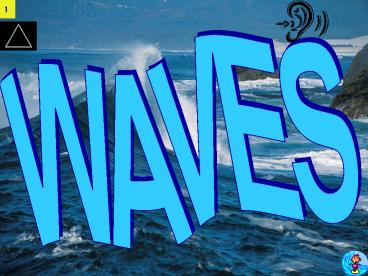WAVES - PowerPoint PPT Presentation
1 / 23
Title:
WAVES
Description:
1 amplitude Frequency & Wavelength Wave interactions with matter Reflection occurs when a wave hits another wave or object that it cannot pass through and bounces ... – PowerPoint PPT presentation
Number of Views:37
Avg rating:3.0/5.0
Title: WAVES
1
1
WAVES
2
Recognize that all waves transfer energy.
2
Explain the phenomena of reflection, refraction,
interference, diffraction.
Relate frequency wavelength to the energy of
different types of electromagnetic waves
mechanical waves.
Relate the speed of sound to different mediums.
Explain the Doppler Effect in terms of everyday
interactions.
Compare and contrast the characteristics of
electromagnetic and mechanical (sound) waves.
3
3
Waves
- Waves are disturbances that carry energy through
matter or space. Clip
- Waves can be visible or invisible evidence of
energy transfer.
- The material does not actually travel with the
wave.. only the energy is carried.
4
Types of Waves
4
- Two types of waves
- Mechanical
- Non-Mechanical
- Mechanical waves need a medium in order to
travel. - Examples Sound, water
- Non-mechanical waves do not need a medium to
travel. - Examples light, gamma waves, microwaves, x-rays
5
Mechanical Waves
5
- Waves that require a medium to travel.
- A medium is the material a wave travels through
- Sound and water.
- Light waves are NOT Mechanical Waves.
6
6
Ways that waves travel
- Transverse waves
- Water, light
- Longitudinal waves
- sound
7
7
Transverse Waves
- Transverse waves are UP DOWN movements.
- The displacement of individual particles is
perpendicular (at right angles) to the direction
of the wave.
EX water waves, radio waves (all EM waves)
8
8
Describing a Transverse Wave
Crest
Trough
9
amplitude
9
The higher the amplitude, the more energy the
wave is carrying In a longitudinal wave- its how
tight the compressions are
10
Frequency Wavelength
10
- Wavelength
- Distance between to identical points on adjacent
waves. - Meters
- As the wavelength decreases the frequency
increases
?
- Frequency
- Number of waves per second
- Hertz
11
9
11
Movement of a Transverse Wave
CLIP
12
Example - Water
12
Remember Energy is transferred ----NOT THE
MATTER!--
13
Longitudinal Waves
13
- Longitudinal waves are a series of PUSHES PULLS
in which the motion of the medium is in the same
direction as the wave
- Ex. Sound Waves
14
14
Characteristics of a Longitudinal (Compressional)
Wave
15
15
Parts of a Longitudinal wave
- Compressions Rarefactions
Rarefaction is a place where the atmospheric
pressure is lowest.
16
16
Speed of a wave
- ? f ?
- ? is the velocity (m/s)
- f is the frequency (hertz)
- ? is the wavelength (m)
- The speed of a mechanical waves is constant for
any given medium..
- The speed of a wave changes as it moves through
different media
17
Wave interactions with matter
17
- Reflection occurs when a wave hits another wave
or object that it cannot pass through and bounces
back.
18
18
Refraction occurs when a wave passes from one
medium to another at an angle and bends (changes
direction) due to a change in speed.
19
19
Diffraction occurs when a wave passes through
an opening and spreads out
- Diffraction is a wave phenomenon that is
dependent on wavelength - Light waves bend as they pass by the edge of a
narrow aperture or slit
20
20
Constructive Interference occurs when two or more
waves hit the same point and combine to produce a
larger single wave.
Destructive Interference occurs when two or more
waves hit the same point and combine to produce a
smaller single wave.
21
Constructive Interference
22
Constructive Interference
Clip
Destructive Interference
23
(No Transcript)































